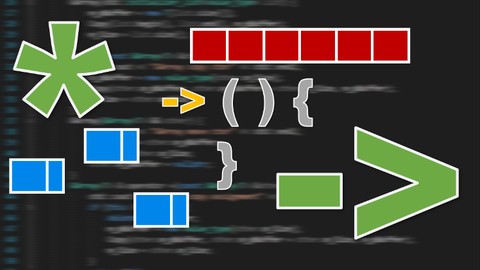
C/C++ Pointers & Applications
C/C++ Pointers & Applications, available at $89.99, has an average rating of 4.6, with 86 lectures, 1 quizzes, based on 159 reviews, and has 1729 subscribers.
You will learn about Understand in depth how pointers work Understand the applications of pointers Understand efficient implementation of basic data structures Understand how callback mechanism works through pointers and objects This course is ideal for individuals who are Anyone who wants to increase their proficiency in C/C++ pointers or Anyone who wants to learn the applications of pointers or Anyone who wants to understand how basic data structures work internally It is particularly useful for Anyone who wants to increase their proficiency in C/C++ pointers or Anyone who wants to learn the applications of pointers or Anyone who wants to understand how basic data structures work internally.
Enroll now: C/C++ Pointers & Applications
Summary
Title: C/C++ Pointers & Applications
Price: $89.99
Average Rating: 4.6
Number of Lectures: 86
Number of Quizzes: 1
Number of Published Lectures: 81
Number of Curriculum Items: 87
Number of Published Curriculum Objects: 81
Original Price: $199.99
Quality Status: approved
Status: Live
What You Will Learn
- Understand in depth how pointers work
- Understand the applications of pointers
- Understand efficient implementation of basic data structures
- Understand how callback mechanism works through pointers and objects
Who Should Attend
- Anyone who wants to increase their proficiency in C/C++ pointers
- Anyone who wants to learn the applications of pointers
- Anyone who wants to understand how basic data structures work internally
Target Audiences
- Anyone who wants to increase their proficiency in C/C++ pointers
- Anyone who wants to learn the applications of pointers
- Anyone who wants to understand how basic data structures work internally
C & C++ are very powerful languages when it comes to performance & flexibility. But there are some features that are complex and take time to master. One of such features is pointers. Pointers is what separates C/C++ from other languages. These are incredibly powerful as they allow programs to access memory directly and manipulate it.
This course focuses on pointers and their applications.It leans more towards implementation in C++, rather C. You’ll learn the basics of pointers and then move on to understanding and implementing arrays, pointers to arrays & heap based arrays. You’ll also learn advanced memory management by creating a custom dynamic array (just like std::vector<T> in standard C++ library). You’ll use placement new & delete to directly place objects in a memory pool allocated through operator new function. As you’ll see later in the course, this is a powerful mechanism to optimize usage of heap memory with user-defined objects.
After arrays, you’ll learn how to use pointers to create node-based data structures. We’ll focus on two types of linked lists – singly & doubly linked lists. You’ll understand the difference between arrays and lists and also learn how to access the elements of both the data structures without having to know their internal structure. This is possible by creating context variables that allows access in a container-agnostic manner.�
Pointers are invaluable while working with strings. You’ll learn how to create dynamic strings using pointers. This will be shown with an implementation of a string class.
The next important topic you’ll learn and implement will be function pointers. You’ll understand how function pointers work and how we can simplify their syntax. You’ll also master the complexity of creating arrays of function pointers and functions that return function pointers. On top of that, you’ll be comfortable with functions returning pointer to functions that themselves return pointer to other functions. Confused? See the section on function pointers.
That’s not all. You’ll also learn how to create pointer to members (which have even a more complex syntax than function pointers).�
Furthermore, you’ll learn how to create callbacks through functions pointers. This course will show you how to optimize the callbacks through function objects. Function objects are more powerful than functions pointers as callbacks.We’ll use this knowledge and apply it in many examples to reinforce the concept of pointers to functions.
This course also introduces some commonly used containers of the C++ standard template library (STL), such as std::array, std::vector & std::list. By the time you hit these topics, you’ll already know how these are implemented internally. How about that!
This course relies on some modern C++ (C++11) features to simplify things, such as auto, std::initializer_lists, type aliases. Even if you don’t know about these features, the course has videos on these topics to get you started. Additionally, there are four full length videos dedicated to discussion on move semantics.
I hope you enjoy this course!
Course Curriculum
Chapter 1: Introduction
Lecture 1: Introduction
Lecture 2: Source Code
Lecture 3: Quick Intro to Modern C++
Lecture 4: Introduction to Pointers
Lecture 5: Examples of Pointers
Chapter 2: Static Arrays
Lecture 1: Source Code
Lecture 2: Array Basics
Lecture 3: Examples of Static Arrays
Lecture 4: Array as Function Argument
Lecture 5: Array as Reference Argument
Lecture 6: Introduction to std::array<T>
Lecture 7: Heap-based Arrays
Lecture 8: Multidimensional Arrays
Lecture 9: Multidimensional Arrays on Heap
Chapter 3: Dynamic Arrays
Lecture 1: Source Code
Lecture 2: Introduction
Lecture 3: Constructors
Lecture 4: Accessors
Lecture 5: Modifiers
Lecture 6: Element Erasure
Lecture 7: Copy/Move Semantics – Part I
Lecture 8: Copy/Move Semantics – Part II
Lecture 9: Copy/Move Semantics – Part III
Lecture 10: Copy/Move Semantics – Part IV
Lecture 11: Copy/Move Semantics Implementation
Lecture 12: Dynamic Array Issues
Lecture 13: Placement new & delete
Lecture 14: Smart Reallocation
Lecture 15: New Dynamic Array I – Constructors
Lecture 16: New Dynamic Array II – Add Function
Lecture 17: New Dynamic Array III – Insert Function
Lecture 18: New Dynamic Array IV – Miscellaneous Functions
Lecture 19: Arrays – Conclusion
Chapter 4: Singly Linked Lists
Lecture 1: Source Code
Lecture 2: Linked Lists Introduction
Lecture 3: Basic Functions
Lecture 4: Modifiers – AddFront & AddBack
Lecture 5: Constructors
Lecture 6: Copy/Move Semantics
Lecture 7: Modifiers – Insertion
Lecture 8: Modifiers – Erase
Lecture 9: Issues
Lecture 10: Element Access
Chapter 5: Doubly Linked Lists
Lecture 1: Source Code
Lecture 2: Basic Functions I
Lecture 3: Basic Functions II
Lecture 4: Modifiers – Add
Lecture 5: Accessors
Lecture 6: Constructors
Lecture 7: Modifiers – Front & End Removal
Lecture 8: Modifiers – Insertion
Lecture 9: Modifiers – Erase
Chapter 6: Strings
Lecture 1: Source Code
Lecture 2: Basics
Lecture 3: String Length
Lecture 4: Copy & Join
Lecture 5: Copy through Allocation
Lecture 6: String Class
Chapter 7: Function Pointers
Lecture 1: Source Code
Lecture 2: Basics I
Lecture 3: Basics II
Lecture 4: Function Pointers As Arguments
Lecture 5: Function Pointers As Return Values – I
Lecture 6: Function Pointers As Return Values – II
Lecture 7: Arrays Of Function Pointers – I
Lecture 8: Arrays Of Function Pointers – II
Chapter 8: Pointer To Member
Lecture 1: Source Code
Lecture 2: Basic Syntax
Lecture 3: Constant Member Functions
Lecture 4: Simplifying Through Macros
Lecture 5: Static Members
Chapter 9: Callbacks
Lecture 1: Source Code
Lecture 2: Introduction
Lecture 3: Function Pointers As Callbacks
Lecture 4: Function Pointers Example
Lecture 5: Member Function As Callback
Lecture 6: Function Objects
Lecture 7: Function Objects As Callbacks
Lecture 8: Function Object Internals
Lecture 9: Function Objects Vs Function Pointers
Lecture 10: BONUS LECTURE
Instructors
-
Umar Lone
Trainer, developer & founder at Poash Technologies
Rating Distribution
- 1 stars: 4 votes
- 2 stars: 2 votes
- 3 stars: 20 votes
- 4 stars: 52 votes
- 5 stars: 81 votes
Frequently Asked Questions
How long do I have access to the course materials?
You can view and review the lecture materials indefinitely, like an on-demand channel.
Can I take my courses with me wherever I go?
Definitely! If you have an internet connection, courses on Udemy are available on any device at any time. If you don’t have an internet connection, some instructors also let their students download course lectures. That’s up to the instructor though, so make sure you get on their good side!
You may also like
- Best Public Speaking Courses to Learn in March 2025
- Best Affiliate Marketing Courses to Learn in March 2025
- Best Email Marketing Courses to Learn in March 2025
- Best Social Media Management Courses to Learn in March 2025
- Best SEO Optimization Courses to Learn in March 2025
- Best Content Creation Courses to Learn in March 2025
- Best Game Development Courses to Learn in March 2025
- Best Software Testing Courses to Learn in March 2025
- Best Big Data Courses to Learn in March 2025
- Best Internet Of Things Courses to Learn in March 2025
- Best Quantum Computing Courses to Learn in March 2025
- Best Cloud Computing Courses to Learn in March 2025
- Best 3d Modeling Courses to Learn in March 2025
- Best Mobile App Development Courses to Learn in March 2025
- Best Graphic Design Courses to Learn in March 2025
- Best Videography Courses to Learn in March 2025
- Best Photography Courses to Learn in March 2025
- Best Language Learning Courses to Learn in March 2025
- Best Product Management Courses to Learn in March 2025
- Best Investing Courses to Learn in March 2025






















